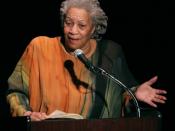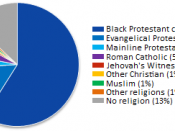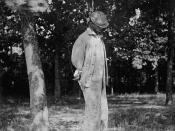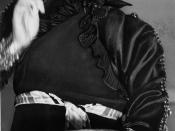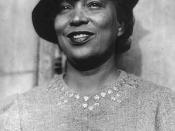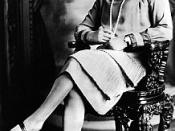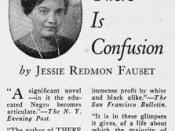Jessie Redmon Fauset's novel, Plum Bun, is a story of African American self-hatred told through the life of the protagonist, Angela Murray and her family, who are divided by color.
Plum Bun was set in the 1920s, which was a time of tremendous change in America in many areas including technology, economics, and civil rights. During that decade, people were moving from farms and rural areas into cities where they began to focus on education in the school systems and civil rights. Cities like New York became filled with men and women seeking to educate themselves, thus developing into one of the most important civil rights movements - the Harlem Renaissance, or the "New Negro Movement." In this movement African Americans, for the first time, began to focus their energies on celebrating their own culture and challenging racism. This celebration was the critical first step required for African Americans to attempt to overcome racism and self-hatred within their own community.
Fauset sets the stage for these issues in Plum Bun by creating a family in which one daughter is extremely light skinned and the other is dark skinned. Angela Murray, the light skinned daughter, is able to "pass" in society as being white. At first "passing" is a lighthearted act, but later it becomes a way of life for her when she leaves her friends and family in Philadelphia and moves to New York to live life as a white woman. "Passing" was common in America and was a manifestation of many problems within the African American society. African Americans were "â¦from the day they are (were) born, bombarded with images to reinforce the "black bad, white good" paradigm. From intellect to beauty to passion to charm to grace to femininity to strength to power we are portrayed as the losers, the lessers, the lamented, unable to shake the "beasts of burden" status we were branded with when we got off the boat in shackles" (Belton). Because of this oppression stemming from the slave era, African Americans were essentially programmed to hold contempt for their own blackness. This is portrayed perfectly in Toni Morrison's The Bluest Eye about a young girl who so much associates her poverty and mistreatment as a human with being black, that she desperately yearns to be white, with blond hair and blue eyes. Morrison skillfully shows the link between this young girl's behavior and the images she is presented with in society: "It had begun with Christmas and the gift of dolls. The big, the special, the loving gift was always a big, blue-eyed Baby Doll. From the clucking sounds of adults I knew that the doll represented what they thought was my fondest wish. I was bemused with the thing itself, and the way it looked. What was I supposed to do with it? Pretend I was its mother?" (Morrison 19). And each time this little girl receives one of these dolls she habitually tears it apart, and then gets punished. In Plum Bun, Angela Murray doesn't have to yearn long, because she can "pass" for white, but she falls victim to the same ideas of color-based worth. She refers to Matthew Henson's typical African American hair with scorn, describing his hair as "thick, tight, 'bad' hair." When she meets Mrs. Powell, one of the only other black characters in the novel, she describes, "Her squarish head capped with a mass of unnaturally straight and unnaturally burnished hair possessed a kind of ugly beauty. Angela could not tell whether her features were good but blurred and blunted by the soft night of her skin or really ugly with an ugliness lost and plunged in that skin's deep concealment" (Fauset 94). When Angela meets Roger Fielding however, she describes him as being "â¦so gay, so beautiful, like a blond, glorious god." By presenting Angela's inner dialogue for us, the reader, Fauset reveals an insightful view into how deeply Angela's subconscious, and the subconscious of many members of the African American community, has been wounded by the white man's ideals of human beauty and value.
Angela also associates her status in life with her identity as a person of color. "â¦the great rewards of life- riches, glamour, pleasure,- are for white-skinned people only" (Fauset 17). Society in America during the era forced people to act out these beliefs which had been fostered by white society to institutionalize and insure its superiority over the African American community. As viewed by white society, from slave-era and beyond, African Americans were often considered to be savage and unscrupulous. When Fauset describes Angela's mother, Mattie, she writes about Mattie's previous employer, a disreputable actress, which only hired colored servants "for hers was a carelessly conducted household, and she felt dimly that all coloured people are thickly streaked with immorality" (Fauset 29). Jesse Redmon Fauset herself fought against this notion of black stereotyping during a time when many African American writers were succumbing to white publisher demands that the white perceived "primitive" black society be represented in literature. "Despite rejections and difficulties, Fauset refused to satisfy the demands of the publishing establishment. Though she knew that the power to pass judgment on her work rested with the white male literary establishment, she refused to compromise her own artistic vision" (McDowell xxvii). Even within the African American community there became a hierarchy regarding "degrees of blackness." Zora Neale Hurston writes, circa 1930's, an informal Glossary of Harlem Slang which portrays the black "color scale" as: "high yaller, yaller, high brown, vaseline brown, seal brown, low brown, dark brown" (Hurston 1008.) This apparent distinction between shades of blackness fostered racist behavior towards individuals within the African American community, mirroring the racist treatment of whites towards the community as a whole. In this sense, African Americans were able to form a hierarchy of racial superiority within their community that provided a sad relief and illusion of superiority independent from the absolute racism inflicted upon them by the white community. The lighter skinned "high yaller" blacks, like Angela Murray, often chose to "pass" as white, in the process usually abandoning their roots. The darker skinned blacks would often refuse to associate with the lighter skinned blacks. Fauset addresses this issue several times in Plum Bun, most poignantly as Angela and Mattie don't acknowledge Junius and Virginia when they walk by during their shopping day, and later when Angela devastatingly refuses to acknowledge Virginia while she is with Roger at the train station. Claude McKay shows us the other side of the coin in his novel Home to Harlem. As he describes the darker side of Harlem he talks about how "high yallers" are scarce in the black clubs because they aren't wanted.
Angela Murray attempts to live as a white woman in white society because she thinks that it is the only way for her to succeed in life. She attempts to marry a white man, even though he is racist, because she thinks that it's the only way to gain status. Angela moves to New York to gain power but she never accomplishes anything until the end of the novel, and only after she begins to learn to love herself. Throughout most of the novel she is completely dependent on Roger, doesn't make many new friends, has very limited choices, and lives in a constant state of fear, loneliness, and depression. Fauset shows us that by denying our roots, we lose touch with ourselves and ultimately become powerless. This is the moral in this "novel without a moral" - only when you accept who you really are, will you be able to harness your inner power. "She (Angela) thought then of all black people, of the race of her parents and of all the odds against living which a cruel, relentless fate had called on them to endure. And she saw them as a people powerfully, almost overwhelmingly endowed with the essence of life. They had to persist, had to survive because they did not know how to die" (Fauset 309).
BibliographyBelton, Danielle. "Fear and Self-Loathing in Black America." The Black Snob. Blogspot.com. 9 Sept. 2008. Web. 30 Oct. 2009. Morrison, Toni. The Bluest Eye. New York: Penguin Group, 1994. Print.
Fauset, Jessie Redmon. Plum Bun: A Novel Without a Moral. Massachusetts: Beacon Press, 1990. Print.
McDowell, Deborah. Introduction. Plum Bun: A Novel Without a Moral. By Jessie Redmon Fauset.1992. Massachusetts: Beacon Press, 1990. ix-xxxiii. Print.
Hurston, Zora Neale. Novels and Stories : Jonah's Gourd Vine / Their Eyes Were Watching God / Moses, Man of the Mountain / Seraph on the Suwanee / Selected Stories. New York: Library of America, 1995. Print.
McKay, Claude. Home to Harlem. Massachusetts: Northeastern, 1987. Print.
